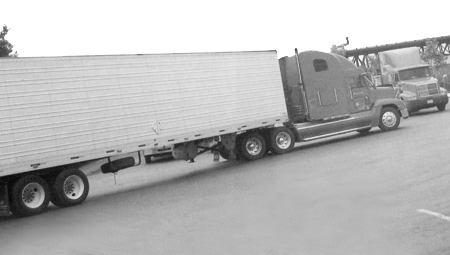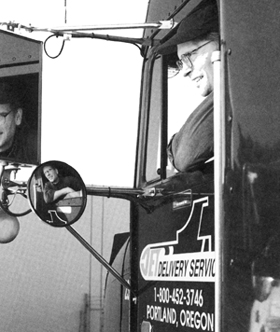
Although we spend countless hours behind the wheel, we often overlook the excellent opportunity driving presents for the practice of mindfulness. Trucker Paul Conrad tells us how the road can be our teacher.
Think about it. You’re hurtling down the highway inside a three-thousand-pound metal box, surrounded by other speeding metal boxes and immovable objects. Delay for a second or two in stepping on the brake, or let the steering wheel veer off by twenty degrees for as long as it takes to draw a breath. . . .
Driving provides continual opportunities for us to wake up, to be mindful. There is no other daily activity for which moment-to-moment awareness is so important, or the consequences of inattention so immediate and potentially catastrophic.
Given this danger, you’d think we’d be in a constant state of hyper-arousal while driving. But in fact, the opposite seems to be true. It’s often difficult to give driving the attention it deserves; we find ourselves zoning out, operating on autopilot. And because of the mental space this allows, we can get caught up in anger, impatience, or anxiety that distract us and can impair our judgment.
Unfortunately, I learned this the hard way. In January of 1986, I rolled a loaded chemical tanker down an embankment just outside the little town of Walcott, Vermont. I was carrying on an imaginary argument with my boss as the miles rolled heedlessly by, so I never noticed the black ice on the highway. All it took was a tap on the brakes to start the rig jackknifing.
Luckily, no one was hurt, and my load stayed contained in the tank. The accident did cost me my job, so I had plenty of time to think about the conditions that had caused it. I realized that my life was awash in anger, turmoil, and confusion, and that these mind states were chronically impairing my driving. I came to be thankful that the crash had gotten me off the highway before I’d killed someone.
I returned to professional driving ten years later, having gained a sense of my own fallibility and mortality. Knowing how costly inattention at the wheel could be, I began searching for ways to become a safer, saner driver—and to cultivate mindfulness behind the wheel.
For five years I worked as a part-time driver, making myself available to fill in for sick or vacationing truckers. I made team runs with over two dozen truckers and got to see how they related to me and to their world.
I drove with several men who were full of a chaotic energy and aggression that appeared to influence all aspects of their lives, including, unfortunately, their driving. With these guys, I strapped myself in as tight as I could and prayed to get home safely.
On the other end of the spectrum, I had the good fortune to drive with a couple of truck drivers I like to think of as Zen masters in cowboy boots. These men brought great focus, alertness, and unflappable calm to their driving. They were mindful at all times behind the wheel, prepared to respond to any situation. They were the kind of trucker I was striving to become.
I began developing some ideas about how drivers’ overall mindsets and attitudes affect their ability to drive safely. To test these ideas out, I interviewed a half-dozen of the best truck drivers in the country. These men and women had each accumulated as many as four million accident-free miles and had won trucking industry accolades. They were not only consummate professionals; they were, for me, teachers of “driving dharma.” They approached the act of driving as a practice, and so I came to think of them as “bodhisattva drivers.”
Mindfulness
Marty Fortun is half of a husband-and-wife team for Schneider National, one of the largest trucking companies in the nation. Marty related to me a sentiment echoed by all the drivers I interviewed: “You have to have a clear head when you’re out on the highway. If your mind is wandering, all it takes is one moment of not paying attention, and the effects can last a lifetime.”
Remaining mindful while driving is much easier said than done, however. How do these drivers stay alert? Conscientious professional drivers start each day with a “pre-trip inspection” of their equipment. They walk around their trucks, ensuring that all mechanical systems are in safe working order. But the “bodhisattva drivers” I interviewed also include an inner inspection—an inspection of themselves.
Harvey Zander has received a number of prestigious trucking industry awards. Here’s what he told me: “The first thing I do in the morning is sit on the edge of my bunk and think for a while. I think about my route, about problems I might encounter. Then I try to psych myself up that it’s going to be a good day, no matter what.”
Sometimes it’s not going to be a good day, no matter what, and as I discovered the hard way, the challenges we face in our lives affect the way we drive. By taking a few quiet moments before we turn that ignition key to assess our mental state, we can identify potential roadblocks to mindful driving.
Sometimes staying mindful while driving is simply a matter of persistence. You keep coming back to what’s in front of you, just as in sitting practice you come back to your breath again and again.
Thomas Barron hauls cryogenic gasses such as liquid oxygen and liquid nitrogen, and copes daily with hazardous loads and congested, chaotic traffic conditions. While he can’t afford mental distractions, his role as a union steward often generates them.
I have days when I’ll take off on a run after arguing with drivers or management, but I try to end the arguments right when I get into the truck. I make my mental pre-trip, and when I get behind the wheel, I go into defensive driving mode. You’ll still be on the road and have the problem click into your mind. When that happens, you just have to start watching the traffic again. As the day progresses, it won’t absorb so much of your mind.
Many people see driving as a dull, repetitive task. But as Vipassana teacher Joseph Goldstein points out, boredom has less to do with the task we’re involved in than with the quality of the attention we bring to it. We can eliminate boredom by cultivating as a mindfulness practice the “defensive driving mode” Barron describes. Scan the highway ahead, looking far down the road for potential hazards. Check your mirrors to monitor traffic alongside and behind you. Take a quick look at the dash to monitor your speedometer and gauges or warning lights. Begin the cycle again, and repeat it. When the mind goes drifting off, bring it back, and start the process once more.
Compassion and Nonviolence

The truck drivers I interviewed do not allow themselves to be provoked by the actions of other drivers. They all believe that as professionals, they must be prepared to compensate for other drivers’ mistakes. Just as Buddhists dedicate meditation practice to the ending of suffering for all beings, these truckers dedicate their driving to the protection of everyone with whom they interact on the road.
Bruce Crager, a thirty-five-year trucking veteran, advises tolerance and understanding of other drivers’ predicaments:
People sometimes get confused when they’re driving, and I think we have to be forgiving of them. And it doesn’t hurt to get out of their way. Old people pulling campers, for instance: They’re likely to make mistakes, and I try to give them a wide berth. I’m a firm believer that what comes around goes around. If you do something bad to somebody, like intentionally cutting them off, somewhere down the road, someone will do the same to you. By the same token, you give a driver a break, maybe give him a hole to slip back into when they need it, and later on, when you need a hole to get out of a dangerous situation, someone will make it for you.
My own trucking experience confirms this. The kind of energy I put out is, by and large, the kind of energy I get back—it’s karma at work.
Finally, all the truckers practiced highway nonviolence. They refuse to respond in kind to aggressiveness by other drivers. Some will go as far as exiting the highway to avoid a potential confrontation.
Ongoing Practice
Even after twenty or thirty years and millions of miles of professional driving, each of these truck drivers believes that he or she still has much to learn. Several said that the day they believe they know it all is the day they should find another line of work. I have learned a lot by letting the road be my teacher. There are new situations happening in each moment, and sometimes I don’t respond as mindfully or as wisely as I could. But over time, I’ve come to welcome the opportunity to learn from the lessons the road presents to me.
My belief is that every moment spent driving mindfully—being fully engaged with the act of driving and allowing learning to take place—adds to our skill, makes us safer, and benefits both us and other drivers. By making a practice of mindful driving, we are training ourselves and cultivating the potential to act with skillful means during moments of crisis, on the road and in the rest of our lives.
Nonharming
All the truckers I interviewed were deeply committed to operating safely at all times. Marty Fortun says, “I don’t care how many miles we drive, we can all fall into bad habits. It’s easy to think, ‘I’m a million-mile driver. I don’t have to worry about safety.’ But you do. Every day you get into that truck, you have to be just as vigilant as on your first day.”
Our natural human tendency to deny the inevitability of suffering and death makes it difficult to sustain an ongoing commitment to safety and contributes to our inattentiveness. On the other hand, if we stay obsessively focused on the hazards of driving, we might never drive, or we’d drive in an agitated state that would pose hazards of its own.
There is, of course, a middle way. If we choose to drive, perhaps we can do so while remaining gently mindful of the responsibility our choice entails. Just as the Buddha advises us to contemplate the inevitability of old age, sickness, and death, so we would do well to hold in our minds the possibility of the suffering that can arise out of our actions behind the wheel, and endeavor in each moment to drive mindfully.
Thank you for subscribing to Tricycle! As a nonprofit, we depend on readers like you to keep Buddhist teachings and practices widely available.